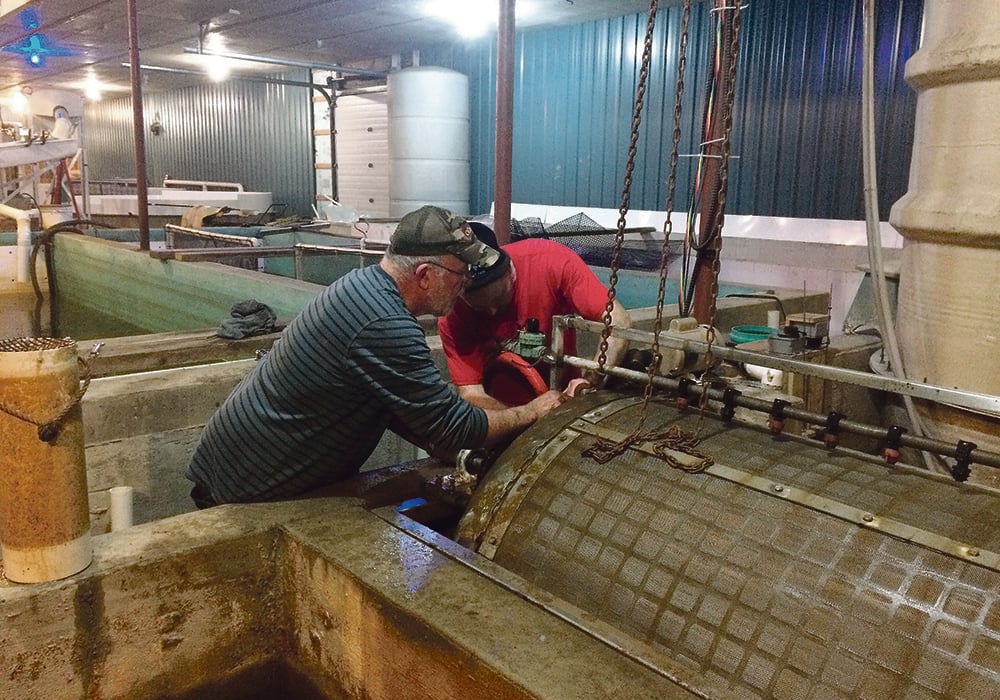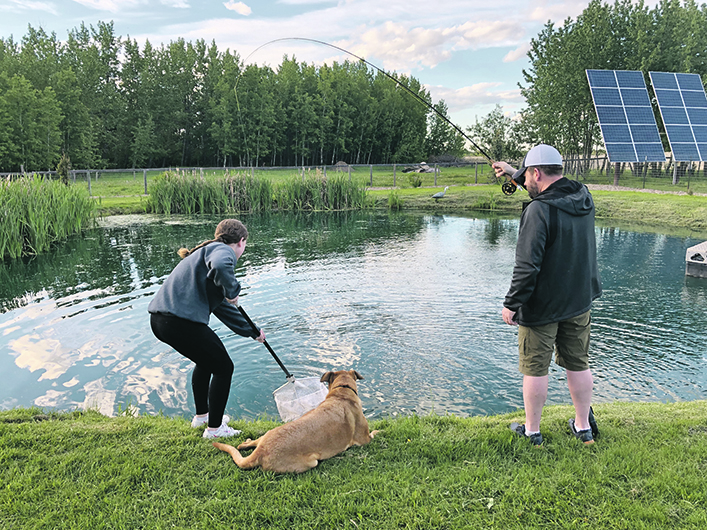A 30 percent increase in purchases of recreational fishing licences helps spark an extra demand for farm to stock fish
If you caught a rainbow or brown trout this year in Alberta, there’s a fair chance you have the Menard family to thank for it.
They’ve turned the unlikely prospect of aquaculture on the Prairies into a business that employs up to seven people, says Max Menard of Smoky Trout Farm Ltd. near Red Deer.
At a time when the COVID-19 pandemic has body-slammed a hard-pressed Alberta economy, demand for the farm’s fish actually grew this year, he says. Customers use the live fish to stock artificial bodies of water that range from man-made lake communities in Calgary to rural dugouts.
Read Also

Farming Smarter receives financial boost from Alberta government for potato research
Farming Smarter near Lethbridge got a boost to its research equipment, thanks to the Alberta government’s increase in funding for research associations.
“You had many people at home not able to go to work, and maybe they’re looking at that old green pond on their property and thinking, ‘well, maybe this is the year that I finally fix it up and put some fish in it,’ and so that caused a fair bit of new demand from people,” says Menard.
He particularly remembers requests to stock fish in tanks at the Timberstone Mews retirement community in Red Deer and at the Carewest Colonel Belcher facility in Calgary.
“I think probably the unique one this year was I had a couple of care homes that came to us that used to take the veterans down to the local fishing pond to take them fishing, and they weren’t able to do that with COVID,” he says.
Smoky Trout Farm donated fish so the residents could continue to enjoy their pastime.

Albertans looking for safe ways to unwind helped fuel a 30 percent jump this year in purchases of recreational fishing licences. It sparked an extra demand to stock fish, says Menard, adding the farm also helped provincial hatcheries facing reduced capacity this year due to renovations.
The farm raised nearly 250,000 fish this year — mostly rainbow trout, with some brown trout — up from the typical 200,000. It supplied about 70,000 fish to the Alberta Conservation Association alone, stocking about 40 bodies of water for the group.
Other customers include homeowner associations for lake communities in Calgary, such as Lake Bonavista, Mahogany and Auburn Bay. He says the farm also stocks holding ponds that provide water for feedlots in the Lethbridge area.
“They’re filled from the irrigation canal, and they get a tremendous amount of shrimp and other aquatic insects and minerals in them. They’re looking for the ability to control some of the growth so that it doesn’t clog off their pump intakes.”
Despite the stronger demand this year, aquaculture on the Prairies isn’t something to take for granted, he says in an e-mail.

“We are nervous about next season because of the risk of a more significant economic downturn. Most of our customers are spending disposable income. It’s those recreational dollars that are the first to get cut when people are forced to pull back on spending.”
Not that things have ever been easy.
“They tell you you’re not a real fish farmer until you’re carrying them out dead in five-gallon buckets, and thankfully, knock on wood, we actually didn’t have too many,” says Menard, recalling what it took to establish the farm in 1998.
Smoky Trout Farm grew out of his parents’ acreage, which contained disused buildings from its previous life as a chicken farm. After taking a course on aquaculture on a whim, the Menard family renovated a chicken barn to hatch and rear fish using about 20 separate tanks, he says.
“It uses much higher energy inputs than if you were growing them, say, in a net pen like the big salmon farms on the West Coast.
“But it also has a much lower environmental footprint because we have a very small amount of water that discharges from our facility, and we don’t have any fish that are in contact with natural fish-bearing waters, or that sort of thing.”
The high density of fish per cubic metre of water means the farm must use a series of pumps and filters to eliminate waste and add oxygen, he says. Ozone and UV lights are also used for sterilization, helping boost the farm’s electricity bill to nearly $40,000 per year.
During the first 12 years, the farm went through a series of renovations and modifications as they learned the business, says Menard.
His brother, Ray, is the farm’s business development manager, with Ray’s wife, Bobbi, helping with marketing. The brothers’ father, Raymond Dan, looks after things such as finances, equipment repairs and overall management, while mom Joey helps with fish feeding and general duties.
“The business would not be where it is today if it weren’t for the crazy amount of long days my parents have put in here over the last 22 years,” says Menard in an e-mail.
His wife, Corrie, will be taking over some of the office duties from his father this winter as his parents, who are in their 70s, slowly step back from day-to-day operations, he says.
People at Smoky Trout Farm carry cellphones linked to an alarm system. Although a generator will automatically fire up if there’s a power outage, it only takes about half an hour for the fish to die if a pump stops working or the oxygen shuts down.
At 2 a.m. on a Sunday, “you could get a low water alarm or a high water alarm, and you’ve got to run down here,” he says. “Somebody has to be on site all the time and within a few minutes of the facility so that you can get in and fix whatever is wrong.”
The live trout market supports about four farm families across Alberta, plus some support staff, says Menard. “There’s not a lot of room for more producers unless someone goes out of business or there was a massive boom in new ponds being dug with an interest in stocking them,” he says.
About 60 percent of the business at Smoky Trout Farm involves raising and stocking fish. The remainder consists of selling aeration systems and treatment products to help customers fight problems such as algal blooms. He says the farm also has a sister brand, Algae Control Canada.
The farm is exploring other opportunities beyond stocking water bodies for recreational use, such as the merits of raising fish for food for grocery stores and restaurants, he says.
“We’re potentially going to dabble in it a little bit here in the next year or two, and if we’re able to build a new facility that has a little bit of increased capacity, then we may end up testing the market a bit,” he says.



















